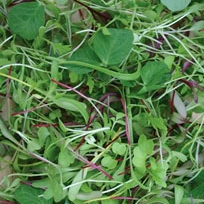You don’t need a backyard garden, a massive balcony or a courtyard to grow your own plant babies. In fact, having a row of neatly potted microgreens inside your home might be an easy fix for anyone who has limited space, lacks a green thumb or doesn’t want to splurge on garnishes in the supermarket.
Why are microgreens so popular to grow?
We had a chat with Chloe Thomson of gardening and cooking show The Gardenettes about her love of microgreens, how to grow them and her tips and tricks for making sure they don’t suffer an unintended sad ending.
“Microgreens are great because you don’t need a garden to grow them and you can easily help them thrive inside,” Thomson said to Lifehacker Australia over the phone.
“You can grow them in things like old punnets, recycled mushroom trays, or things you buy from supermarkets that come in those clear plastic trays, so it’s really no fuss at all.”
You may not realise it but microgreens, also called ‘vegetable confetti’, are grown from normal seeds but are harvested early. They fall somewhere between sprouts and baby salad greens and are filled with lots of nutrients. In fact, you’ll most likely save a bunch of money growing these on your own instead of dishing out $5 or more for basil or coriander that will last you just a few days.
What microgreens can you grow?
What you want to grow depends on your intentions. Do you want something that looks pretty or do you want it to add a punchy or peppery flavour to your food?
“You know, something that just looks pretty but isn’t very flavourful would be beetroot leaves when they’re at their micro stage,” Thomson said.
“Herbs on the other hand are generally quite packed with flavour. So things like basil, coriander, parsley – they’re really nice to grow as you can pop them on things like ice cream or a really sweet little lemon tart or use them to garnish your savoury dishes.”
Alternatively, you could also grow dill, chervil, snow peas, brassicas, kale or cabbage.
How to grow microgreens from seed
Thomson explained all you have to do to grow your own microgreen is pop in some potting mix in a punnet or tray and sprinkle in the microgreen seeds and then leave them on the windowsill.
Thomsan suggests taking a shallow pot or whatever you decide to use and giving it a good wash out. Make sure your pot has drainage holes in the bottom. Sometimes punnets don’t have them, so you may need to make a few holes yourself.
You can use a seed-raising mix, but you can just as easily get away with using a normal potting mix.
Follow the instructions on the packet your microgreen seeds came in. According to Thomson, you can either get different microgreen seed packet mixes or you can just go and buy a packet of lettuce seeds, for instance, and sprinkle them onto your soil and let them sprout that way.
“But, the trick with the microgreen seeds is you’re not trying to space them out, like you’re going to grow them in a garden, you’re actually sort of layering them on sticks, so to speak,” Thomson said.
“So you’re you’re looking for the seeds to be all very close together, but on a single layer over the top of that soil, and then you either very lightly sprinkle them or dust them with a bit more potting mix or a grazing mix, or you’re just experimentally pressing them down into the mix so they’ve got contact.”
Tip: If you’re a beginner, it might be best to avoid mixing seed types as they germinate at different speeds. Grow each microgreen in a separate punnet. Here’s a video in case you prefer a visual guide:
How long do they take to grow?
Growing microgreens is great because they take relatively less time to sprout. But how long they take still depends on what you’re trying to grow.
“You’ll have radishes sprouting in about four days after you’ve planted them and you’ll then be able to harvest them probably in another four or five days,” Thomson explained.
“So, you could have something like radish microgreens ready to be snipped in less than two weeks, but something a little bit slower-growing like coriander might take you maybe two-to-four weeks before it’s ready to be used.”
Things you should avoid
This should come as no surprise, but alas, Thomson said, over-watering microgreens is always the biggest concern.
“When you do that, you get mould growing on the surface and that makes your soil mouldy, soggy, wet, gross and slimy.”
Having said that, your microgreens do need moisture and water, but don’t have them sitting on a saucer that’s filled with water as that won’t allow them to drain between waterings.
“I would suggest using a mister or a spray bottle as it will help avoid flooding your microgreen pots with water,” she said.
Secondly, Thomson explained you should keep them as close to a windowsill as possible.
The plants will automatically sort of arch towards the window as that’s their way of following the sunlight.
“You can just rotate your little punnet 90 degrees every day. That’ll keep them growing straight.
“Give them as much light as you possibly can, though you need to be careful in the summer. I wouldn’t put them on a north facing or a west facing windowsill as too much of the hot afternoon sun can be bad for your plants.”
Give us a shout in the comments if you have your own tips and tricks to share.

Leave a Reply
You must be logged in to post a comment.